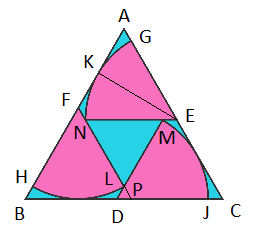Wedges in a triangle 1
Three 6 0 ∘ -sectors of a unit circle pack neatly inside an equilateral triangle.
The side length of this triangle can be written as A + C B , where A , B , C are integers with C square-free.
What is the value of A + B + C ?
The answer is 6.
This section requires Javascript.
You are seeing this because something didn't load right. We suggest you, (a) try
refreshing the page, (b) enabling javascript if it is disabled on your browser and,
finally, (c)
loading the
non-javascript version of this page
. We're sorry about the hassle.
4 solutions
Can we rearrange the sectors because given its equilateral triangle and sectors also of 60° ?
Why 1 + 2/√3 equals 1+2+3?🤔 Need help
Log in to reply
The problem says the side length is in the form of A + C B and is asking for A + B + C .
The exact side length is 1 + 3 2 so the answer is 1 + 2 + 3 = 6 .
"The area can be written as..." please change area to side length, or it is quite confusing.
Log in to reply
Thanks. Thinking of several problems simultaneously.
Which meaning of "soon" were you thinking of? >:-]
Log in to reply
lol. Two posted solutions are better than or equivalent to mine. I have nothing to add.
The y-coordinates of the 3 apexes are 0, 1 and cos 60°. Their mean must be the center of the triangle, 3 1 + 2 1 3 , so the height of the triangle is 3 times this h = 1 + 2 1 3 , and the side s = 3 2 h = 3 2 + 1 , so the answer is 1+2+3=6
Since i think noone has managed to over-complicate things as much as i usually do, here's how i solved this:

Since EGN is a sector of a unit circle, EK = 1, and since ∠ N E G = 6 0 ∘ then ∠ A E K = 3 0 ∘ , and AE = 2 * AK. Using Pythagoras, 3 × A K 2 = E K 2 = 1 so A K = 3 1 . Since AE = 2 * AK, A E = 3 2 .
Due to symmetry, B F = C D = A E = 3 2 . And C J = C D − D J = 3 2 − 1 .
Extending FL until it meets BC at P, we have ∠ L D P = ∠ M D J = 6 0 ∘ . Since ABC is equilateral, then ∠ A B C = 6 0 ∘ , and since ∠ B F P = ∠ H F L = 6 0 ∘ then ∠ F P B = ∠ L P D = 6 0 ∘ , therefore the LPD triangle is also equilateral.
Thus B C = B P + C D − D P = B F + C D − ( F P − F L ) = 3 2 + 3 2 − ( 3 2 − 1 ) = 1 + 3 2 . So A = 1 , B = 2 , C = 3 , and A + B + C = 6 .
Label the points as shown below, and draw E F as the bisector of the sector and also draw B C .
Since △ A B C is a unit equilateral triangle, B C = 1 , and since D E = B C , D E = 1 .
As a radius of the sector, E F = 1 , and as a bisector of the 6 0 ° angle, ∠ F E G = 3 0 ° , and as a tangent, ∠ E F G is a right angle. Therefore E G = cos 3 0 ° 1 = 3 2 .
The side length D G is therefore D E + E G = 1 + 3 2 , so A = 1 , B = 2 , and C = 3 , and A + B + C = 6 .